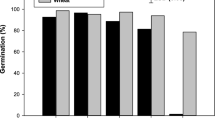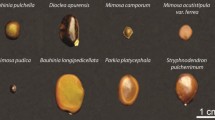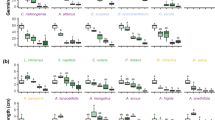Abstract
Podophyllum hexandrum Royle, an important alpine herb, and a source of the highly valued aryltetralin-type lignan, podophyllotoxin, has been subjected to heavy collection from the wild due to ever increasing demand. The present study deals with an attempt to bring this plant under cultivation at a relatively lower altitude and to evaluate (1) various growth parameters including above and below ground biomass accumulation, net assimilation rate and relative growth rate, etc., and (2) podophyllotoxin content from the resulting above and below ground biomass in seed raised plants of a known age series of 1–5 years. The podophyllotoxin content was estimated on the basis of HPLC analyses. The levels were found to increase with the plant age and the maximum amount was found in 5-year old plants. This study demonstrates that (1) seeds can be conveniently used for raising healthy propagules in easily approachable locations at a relatively lower altitude, and that the plants can be maintained in such sites over long periods, and (2) this approach of “conservation through cultivation” can be suggested as an effective tool for the management of this “critically endangered status” species.


Similar content being viewed by others
References
Aung LH (1990) Growth substances and environment on the development of vegetative storage organs. In: Purohit SS (ed) Hormonal regulation of plant growth and development. Agro Botanical Publishers, Bikaner, pp 91–106
Beutner KR, von Krogh G (1990) Current status of podophyllotoxin for the treatment of genital warts. Semin Dermatol 9:148–151
Bhadula SK, Singh A, Lata H, Kuniyal CP, Purohit AN (1996) Genetic resources of Podophyllum hexandrum Royle, an endangered medicinal species from Garhwal Himalaya, India. Plant Genet Resour Newsl 106:26–29
Baronov A (1966) Recent advances in our knowledge of the morphology, cultivation and uses of ginseng (Panex ginseng A Meyer). Econ Bot 20:403–406
Canel C, Moreas RM, Dyan FE, Ferreira D (2000) Molecules of interest: Podophyllotoxin. Phytochemistry 54:115–120
Canel C, Dayan FE, Ganzera M, Khan IA, Rimando A, Burandt CL, Moraes RM (2001) High yield of podophyllotoxin from leaves of Podophyllum peltatum by in situ conversion of podophyllotoxin 4-O-β-d glucopyranoside. Planta Medica 67:97–99
Chauhan RS, Nautiyal MC (2005) Commercial viability of an endangered medicinal herb Nardostachys jatamansi at three different agroclimatic zones. Curr Sci 89:1481–1488
Evans GC (1972) The quantitative analysis of plant growth. Black Well, Oxford
Fay DA, Ziegler HW (1985) Botanical source differentiation of Podophyllum resin by high performance liquid chromatography. J Liq Chromatogr 8:1501–1506
Nadeem M, Palni LMS, Purohit AN, Pandey H, Nandi SK (2000) Propagation and conservation of Podophyllum hexandrum Royle: an important medicinal herb. Biol Conser 92:121–129
Nadeem M (2001) Mass propagation and conservation strategies for two medicinally important plants of the Himalayan region. PhD thesis, Kumaun University, Nainital
Nautiyal MC (1986) Physiology of reproduction in two Aconitum species. PhD thesis H. N. B. Garhwal University, Srinagar
Nautiyal BP, Prakash V, Chauhan RS, Purohit H, Nautiyal MC (2001) Assesment of germinability, productivity and cost benefit analysis of Picrorhiza kurrooa cultivated at lower altitude. Cur Sci 81:579–585
Nigam KB (1984) Ashwagandha cultivation. Ind Hortic 28:39–41
Pandey H, Nandi SK, Chandra B, Nadeem M, Palni LMS (2001) GA3 induced flowering in Podophyllum hexandrum Royle: a rare alpine medicinal herb. Acta Physiol Plant 23:467–474
Pandey H (2002) Studies in relation to cotyledonary senescence and tissue culture of medicinally important alpine herbs. PhD thesis, Kumaun University, Nainital
Purohit MC, Bahuguna R, Maithani UC, Purohit AN, Rawat AN, Rawat MSM (1999) Variation in podophylloresin and podophyllotoxin content in different populations of Podophyllum hexandrum. Cur Sci 77:1078–1080
Samant SS, Dhar U, Palni LMS (1998) Medicinal plants of Himalaya: diversity distribution and potential values. Himvikas, Gyanodaya Prakashan, Nainital, p 163
Sharma P, Sett R (2001) Micropropagation of Indian ginseng (Panex pseudoginseng Wall): a proposition to save an endangered commercial and medicinal forest plant. J Human Eco 12:201–205
Singh A (1992) Ecophysiology of Podophyllum hexandrum Royle. PhD thesis, H. N. B. Garhwal University, Srinagar
Snedecor GW, Cochran WG (1967) Statistical methods. Oxford and IBH, New Delhi, p 593
Stoltz LP, Snyder JC (1985) Embryo growth and germination of American ginseng seed in response to stratification temperature. Hort Sci 20:261–262
Van Uden W, Pras N, Visser JF, Malingre ThM (1989) Detection and identification of podophyllotoxin produced by cell cultures derived from Podophyllum hexandrum Royle. Plant Cell Rep 8:165–168
Varshney A, Dhawan V, Srivastava PS (2001) Ginseng: wonder drug of the world. In: Khan IA, Khanum A (eds) Role of biotechnology in medicinal and aromatic plants. Ukaaz Publication, India pp 26–41
Whitehead FH, Myerscough PJ (1962) Growth analysis of plants. The ratio of mean relative growth rate to mean relative rate of leaf area increase. New Phytol 61:314–321
Woodward FI, Piggot CD (1975) The climatic control of the altitudinal distribution of Sedum rosea (L.) Scop and S. telephinum L. 1. Field observations. New Phytol 74:323–334
Woodward FI (1979) The differential temperature response of the growth of certain plant species from different altitudes. I. Growth analysis of Phleum alpinum L., P. bertolonii DC, Sesleria albicanas Kit.and Dactylis glomerata L. New Phytol 82:385–395
Acknowledgments
Financial support to Hemant Pandey from a project funded by the Department of Biotechnology, Government of India is duly acknowledged. The Ministry of Environment and Forests, Government of India and the Director of the Institute are also thanked for providing facilities.
Author information
Authors and Affiliations
Corresponding author
Additional information
Communicated by M. Horbowicz.
Rights and permissions
About this article
Cite this article
Pandey, H., Nandi, S.K., Kumar, A. et al. Podophyllotoxin content in Podophyllum hexandrum Royle plants of known age of seed origin and grown at a lower altitude. Acta Physiol Plant 29, 121–126 (2007). https://doi.org/10.1007/s11738-006-0015-0
Received:
Accepted:
Published:
Issue Date:
DOI: https://doi.org/10.1007/s11738-006-0015-0




